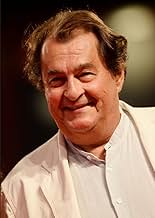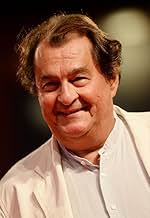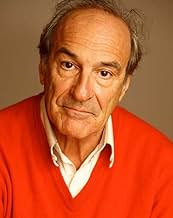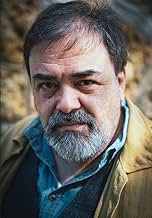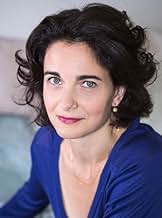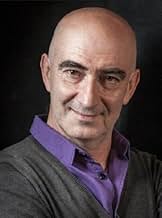ÉVALUATION IMDb
6,2/10
8,2 k
MA NOTE
Le gouvernement demande à Eiffel de concevoir quelque chose de spectaculaire pour l'Exposition universelle de Paris de 1889, mais Eiffel veut simplement concevoir le métro. Tout change quand... Tout lireLe gouvernement demande à Eiffel de concevoir quelque chose de spectaculaire pour l'Exposition universelle de Paris de 1889, mais Eiffel veut simplement concevoir le métro. Tout change quand Eiffel revoit une mystérieuse femme.Le gouvernement demande à Eiffel de concevoir quelque chose de spectaculaire pour l'Exposition universelle de Paris de 1889, mais Eiffel veut simplement concevoir le métro. Tout change quand Eiffel revoit une mystérieuse femme.
- Prix
- 1 victoire et 8 nominations au total
Jérémy Lopez
- Maurice Koechlin
- (as Jérémy Lopez de la Comédie Française)
Joseph Rezwin
- R. Milligan McLane
- (as Joe Rezwin)
Benoit de Gauléjac
- Un banquier
- (as Benoît de Gaulejac)
Histoire
Le saviez-vous
- AnecdotesWriter Caroline Bongrand came with the idea of mixing the building of the Eiffel Tower with a forbidden love story off the top of her head during a pitch session with a producer in Los Angeles without knowing at this time if it had any basis in reality. It was only after the deal with the producer was signed that she browsed through biographies of Gustave Eiffel and discovered that her inventions were almost all true.
- GaffesWhen Gustave and Adrienne kiss on the first floor of the tower being constructed, the sun is shown as setting to the right of the then-palace on top of Trocadero Hill, i.e. to the North-North-West of Paris, when it should rather be to the South-West.
- Bandes originalesNini Peau d'Chien
Music by Aristide Bruant
Commentaire en vedette
The government is asking Eiffel to design something spectacular for the 1889 Paris World Fair, but Eiffel simply wants to design the subway. Suddenly, everything changes when Eiffel crosses paths with a mysterious woman from his past. September 1886 - Eiffel receives an award for his groundbreaking design for an iron skeleton to support the Statue of Liberty. Afterward, he considers what his next construction should be, for the 1889 World's Fair in Paris. Two of his employees, Maurice Koechlin and Émile Nouguier, propose a 200-meter steel tower, but he turns down their proposal, favoring a Metro system for Paris. In order to get publicity for his enterprise, he contacts an old friend, journalist Antoine de Restac. At a society party, Eiffel meets Restac's wife, Adrienne. They have a strange, instant connection. Transfixed by her, Eiffel suddenly announces he will build a 300-meter steel tower, shocking the other guests. In 1886 - Eiffel presents his plans for the tower to the judges for the competition. At the ceremony to announce the winner, as his name is announced, Eiffel and Adrienne instinctively hold hands. Restac sees this. Eiffel begins construction of the tower. At a garden party, he dances with Adrienne and asks her to meet him at a cheap hotel in the country. She refuses. As construction continues, the workers threaten to strike. Adrienne realizes Restac has become suspicious of her. She searches his things and finds a cartoon belittling Eiffel's tower. Out of jealousy, Restac is using his position as a top journalist to sabotage public opinion against the tower. With uncertainty clouding the whole undertaking, the workers at the tower go on strike. Then , Restac, who married Adrienne and nursed her back to health after her family abandoned her, is aware of her affair with Eiffel.
Eiffel is a 2021 French romantic drama film professionally directed by Martin Bourboulon, from a script written by Caroline Bongrand. Eiffel premiered on 2 March 2021 at the Alliance Française French Film Festival in Australia, and was released in France on 13 October 2021, by Pathé Distribution . The film stars Romain Duris as Gustave Eiffel and follows a fictionalized romance between Eiffel and Adrienne Bourgès, his childhood sweetheart, well played by Emma Mackey, both of them perform some erotic scenes while making love . It also stars Pierre Deladonchamps in a supporting role. Not a biopic so much as a sketchy piece of historical fiction, relying heavily on the love relationship between Gustave Eiffel and Adrienne Bourgès , while telling the various interested parties when he makes his formal bid to build the tower. Ambitious, handsomely appointed but some boring film , resulting to be an unapologetically old-fashioned flick.
The picture contains some biographic depiction about Eiffel (1832-1923) who was a French civil engineer. A graduate of École Centrale des Arts et Manufactures, he made his name with various bridges for the French railway network, most famously the Garabit Viaduct. He is best known for the world-famous Eiffel Tower, designed by his company and built for the 1889 Universal Exposition in Paris, and his contribution to building the Statue of Liberty in New York. After his retirement from engineering, Eiffel focused on research into meteorology and aerodynamics, making significant contributions in both fields. . The Eiffel tower design was exhibited at the Exhibition of Decorative Arts in the autumn of 1884, and on 30 March 1885 Eiffel read a paper on the project to the Société des Ingénieurs Civils. After discussing the technical problems and emphasising the practical uses of the tower, he finished his talk by saying that the tower would symbolise. . The design was exhibited at the Exhibition of Decorative Arts in the autumn of 1884, and on 30 March 1885 Eiffel read a paper on the project to the Société des Ingénieurs Civils. After discussing the technical problems and emphasising the practical uses of the tower, he finished his talk by saying that the tower would symbolise "not only the art of the modern engineer, but also the century of Industry and Science in which we are living, and for which the way was prepared by the great scientific movement of the eighteenth century and by the Revolution of 1789, to which this monument will be built as an expression of France's gratitude."Little happened until the beginning of 1886, but with the re-election of Jules Grévy as president and his appointment of Edouard Lockroy as Minister for Trade decisions began to be made. A budget for the Exposition was passed and on 1 May Lockroy announced an alteration to the terms of the open competition which was being held for a centerpiece for the exposition, which effectively made the choice of Eiffel's design a foregone conclusion: all entries had to include a study for a 300 m (980 ft) four-sided metal tower on the Champ de Mars. On 12 May a commission was set up to examine Eiffel's scheme and its rivals and on 12 June it presented its decision, which was that only Eiffel's proposal met their requirements. After some debate about the exact site for the tower, a contract was signed on 8 January 1887. This was signed by Eiffel acting in his own capacity rather than as the representative of his company, and granted him one and a half million francs toward the construction costs. This was less than a quarter of the estimated cost of six and a half million francs. Eiffel was to receive all income from the commercial exploitation during the exhibition and for the following twenty years. Eiffel later established a separate company to manage the tower. The tower had been a subject of some controversy, attracting criticism both from those who did not believe it feasible and from those who objected on artistic grounds. Just as work began at the Champ de Mars, the "Committee of Three Hundred" was formed, led by Charles Garnier and including some of the most important figures of the French arts establishment, including Adolphe Bouguereau, Guy de Maupassant, Charles Gounod and Jules Massenet: a petition was sent to Jean-Charles Adolphe Alphand, the Minister of Works, and was published by Le Temps."To bring our arguments home, imagine for a moment a giddy, ridiculous tower dominating Paris like a gigantic black smokestack, crushing under its barbaric bulk Notre Dame, the Tour Saint-Jacques, the Louvre, the Dome of les Invalides, the Arc de Triomphe, all of our humiliated monuments will disappear in this ghastly dream". Work on the foundations started on 28 January 1887. Those for the east and south legs were straightforward, each leg resting on four 2 m concrete slabs, one for each of the principal girders of each leg but the other two, being closer to the river Seine were more complicated: each slab needed two piles installed by using compressed-air caissons 15 m long and 6 m in diameter driven to a depth of 22 m to support the concrete slabs, which were 6 m thick. Each of these slabs supported a limestone block, each with an inclined top to bear the supporting shoe for the ironwork. Although no more than 250 men were employed on the site, a prodigious amount of exacting preparatory work was entailed: the drawing office produced 1,700 general drawings and 3,629 detail drawings of the 18,038 different parts needed. The task of drawing the components was complicated by the complex angles involved in the design and the degree of precision required: the positions of rivet holes were specified to within 0.1 mm and angles worked out to one second of arc. The components, some already riveted together into sub-assemblies, were first bolted together, the bolts being replaced by rivets as construction progressed. No drilling or shaping was done on site: if any part did not fit it was sent back to the factory for alteration. The four legs, each at an angle of 54° to the ground, were initially constructed as cantilevers, relying on the anchoring bolts in the masonry foundation blocks.
Eiffel is a 2021 French romantic drama film professionally directed by Martin Bourboulon, from a script written by Caroline Bongrand. Eiffel premiered on 2 March 2021 at the Alliance Française French Film Festival in Australia, and was released in France on 13 October 2021, by Pathé Distribution . The film stars Romain Duris as Gustave Eiffel and follows a fictionalized romance between Eiffel and Adrienne Bourgès, his childhood sweetheart, well played by Emma Mackey, both of them perform some erotic scenes while making love . It also stars Pierre Deladonchamps in a supporting role. Not a biopic so much as a sketchy piece of historical fiction, relying heavily on the love relationship between Gustave Eiffel and Adrienne Bourgès , while telling the various interested parties when he makes his formal bid to build the tower. Ambitious, handsomely appointed but some boring film , resulting to be an unapologetically old-fashioned flick.
The picture contains some biographic depiction about Eiffel (1832-1923) who was a French civil engineer. A graduate of École Centrale des Arts et Manufactures, he made his name with various bridges for the French railway network, most famously the Garabit Viaduct. He is best known for the world-famous Eiffel Tower, designed by his company and built for the 1889 Universal Exposition in Paris, and his contribution to building the Statue of Liberty in New York. After his retirement from engineering, Eiffel focused on research into meteorology and aerodynamics, making significant contributions in both fields. . The Eiffel tower design was exhibited at the Exhibition of Decorative Arts in the autumn of 1884, and on 30 March 1885 Eiffel read a paper on the project to the Société des Ingénieurs Civils. After discussing the technical problems and emphasising the practical uses of the tower, he finished his talk by saying that the tower would symbolise. . The design was exhibited at the Exhibition of Decorative Arts in the autumn of 1884, and on 30 March 1885 Eiffel read a paper on the project to the Société des Ingénieurs Civils. After discussing the technical problems and emphasising the practical uses of the tower, he finished his talk by saying that the tower would symbolise "not only the art of the modern engineer, but also the century of Industry and Science in which we are living, and for which the way was prepared by the great scientific movement of the eighteenth century and by the Revolution of 1789, to which this monument will be built as an expression of France's gratitude."Little happened until the beginning of 1886, but with the re-election of Jules Grévy as president and his appointment of Edouard Lockroy as Minister for Trade decisions began to be made. A budget for the Exposition was passed and on 1 May Lockroy announced an alteration to the terms of the open competition which was being held for a centerpiece for the exposition, which effectively made the choice of Eiffel's design a foregone conclusion: all entries had to include a study for a 300 m (980 ft) four-sided metal tower on the Champ de Mars. On 12 May a commission was set up to examine Eiffel's scheme and its rivals and on 12 June it presented its decision, which was that only Eiffel's proposal met their requirements. After some debate about the exact site for the tower, a contract was signed on 8 January 1887. This was signed by Eiffel acting in his own capacity rather than as the representative of his company, and granted him one and a half million francs toward the construction costs. This was less than a quarter of the estimated cost of six and a half million francs. Eiffel was to receive all income from the commercial exploitation during the exhibition and for the following twenty years. Eiffel later established a separate company to manage the tower. The tower had been a subject of some controversy, attracting criticism both from those who did not believe it feasible and from those who objected on artistic grounds. Just as work began at the Champ de Mars, the "Committee of Three Hundred" was formed, led by Charles Garnier and including some of the most important figures of the French arts establishment, including Adolphe Bouguereau, Guy de Maupassant, Charles Gounod and Jules Massenet: a petition was sent to Jean-Charles Adolphe Alphand, the Minister of Works, and was published by Le Temps."To bring our arguments home, imagine for a moment a giddy, ridiculous tower dominating Paris like a gigantic black smokestack, crushing under its barbaric bulk Notre Dame, the Tour Saint-Jacques, the Louvre, the Dome of les Invalides, the Arc de Triomphe, all of our humiliated monuments will disappear in this ghastly dream". Work on the foundations started on 28 January 1887. Those for the east and south legs were straightforward, each leg resting on four 2 m concrete slabs, one for each of the principal girders of each leg but the other two, being closer to the river Seine were more complicated: each slab needed two piles installed by using compressed-air caissons 15 m long and 6 m in diameter driven to a depth of 22 m to support the concrete slabs, which were 6 m thick. Each of these slabs supported a limestone block, each with an inclined top to bear the supporting shoe for the ironwork. Although no more than 250 men were employed on the site, a prodigious amount of exacting preparatory work was entailed: the drawing office produced 1,700 general drawings and 3,629 detail drawings of the 18,038 different parts needed. The task of drawing the components was complicated by the complex angles involved in the design and the degree of precision required: the positions of rivet holes were specified to within 0.1 mm and angles worked out to one second of arc. The components, some already riveted together into sub-assemblies, were first bolted together, the bolts being replaced by rivets as construction progressed. No drilling or shaping was done on site: if any part did not fit it was sent back to the factory for alteration. The four legs, each at an angle of 54° to the ground, were initially constructed as cantilevers, relying on the anchoring bolts in the masonry foundation blocks.
- ma-cortes
- 17 avr. 2023
- Lien permanent
Meilleurs choix
Connectez-vous pour évaluer et surveiller les recommandations personnalisées
- How long is Eiffel?Propulsé par Alexa
Détails
- Date de sortie
- Pays d’origine
- Sites officiels
- Langues
- Aussi connu sous le nom de
- Eiffel in Love
- Lieux de tournage
- sociétés de production
- Consultez plus de crédits d'entreprise sur IMDbPro
Box-office
- Brut – États-Unis et Canada
- 444 814 $ US
- Fin de semaine d'ouverture – États-Unis et Canada
- 42 394 $ US
- 1 mai 2022
- Brut – à l'échelle mondiale
- 13 573 923 $ US
- Durée1 heure 48 minutes
- Couleur
- Mixage
- Rapport de forme
- 2.39 : 1
Contribuer à cette page
Suggérer une modification ou ajouter du contenu manquant




